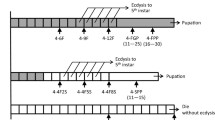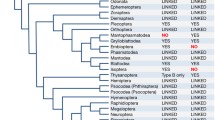Abstract
The C-terminal binding protein (CtBP) is an evolutionarily conserved transcriptional corepressor found in multicellular eukaryotes. Multiple forms of the protein are typically found in animal cells, produced from separate genes and by alternative splicing. CtBP isoforms have also been implicated in cytoplasmic functions, including Golgi fission and vesicular trafficking. All forms of CtBP contain a conserved core domain that is homologous to α-hydroxyacid dehydrogenases, and a subset of isoforms (CtBPL) contain extensions at the C terminus. Despite distinct developmental profiles and knockout phenotypes in the mouse, the properties of different isoforms of the protein are found to be similar in many transcriptional assays. We have investigated the expression and conservation of distinct isoforms of the CtBP protein in insects and found that the expression of multiple, developmentally regulated isoforms is widely conserved. In a variety of Drosophila species, the relative abundance of CtBPL to CtBPS drops sharply after embryogenesis, revealing a conserved developmental shift. Despite the overall lower levels of this isoform, bioinformatic analysis reveals that exons encoding the C-terminal extension in CtBPL are conserved from Diptera to Coleoptera, suggesting that the CtBPL isoform contributes an important, evolutionarily conserved function.




Similar content being viewed by others
References
Balasubramanian P, Zhao LJ, Chinnadurai G (2003) Nicotinamide adenine dinucleotide stimulates oligomerization, interaction with adenovirus E1A and an intrinsic dehydrogenase activity of CtBP. FEBS Lett 537:157–160
Barnes CJ, Vadlamudi RK, Mishra SK, Jacobson RH, Li F, Kumar R (2003) Functional inactivation of a transcriptional corepressor by a signaling kinase. Nat Struct Biol 10:622–628
Chinnadurai G (2003) CtBP family proteins: more than transcriptional corepressors. Bioessays 1:9–12
Chinnadurai G (2005) CtBP family proteins: unique transcriptional regulators in the nucleus with diverse cytosolic functions. In: Chinnadurai G (ed) CtBP family proteins. Landes Bioscience, Georgetown, Texas, pp 1–17
Corda D, Colanzi A, Luini A (2006) The multiple activities of CtBP/BARS proteins: the Golgi view. Trends Cell Biol 16:167–173
Fang M, Li J, Blauwkamp T, Bhambhani C, Campbell N, Cadigan KM (2006) C-terminal-binding protein directly activates and represses Wnt transcriptional targets in Drosophila. EMBO J 25:2735–2745
Gallop JL, Butler PJ, McMahon HT (2005) Endophilin and CtBP/BARS are not acyl transferases in endocytosis or Golgi fission. Nature 438:675–678
Hildebrand JD, Soriano P (2002) Overlapping and unique roles for C-terminal binding protein 1 (CtBP1) and CtBP2 during mouse development. Mol Cell Biol 15:5296–5307
Kagey MH, Melhuish TA, Wotton D (2003) The polycomb protein Pc2 is a SUMO E3. Cell 1:127–137
Kumar V, Carlson JE, Ohgi KA, Edwards TA, Rose DW, Escalante CR, Rosenfeld MG, Aggarwal AK (2002) Transcription corepressor CtBP is an NAD(+)-regulated dehydrogenase. Mol Cell 4:857–869
Li X, Noll M (1994) Compatibility between enhancers and promoters determines the transcriptional specificity of gooseberry and gooseberry neuro in the Drosophila embryo. EMBO J 13: 400–406
Lin X, Sun B, Liang M, Liang YY, Gast A, Hildebrand J, Brunicardi FC, Melchior F, Feng XH (2003) Opposed regulation of corepressor CtBP by SUMOylation and PDZ binding. Mol Cell 5:1389–1396
Linding R, Russell RB, Neduva V, Gibson TJ (2003) GlobPlot: exploring protein sequences for globularity and disorder. Nucleic Acids Res 31:3701–3708
Nardini M, Spanò S, Cericola C, Pesce A, Massaro A, Millo E, Luini A, Corda D, Bolognesi M (2003) CtBP/BARS: a dual-function protein involved in transcription co-repression and Golgi membrane fission. EMBO J 22:3122–3130
Nardini M, Svergun D, Konarev PV, Spano S, Fasano M, Bracco C, Pesce A, Donadini A, Cericola C, Secundo F, Luini A, Corda D Bolognesi M (2006) The C-terminal domain of the transcriptional corepressor CtBP is intrinsically unstructured. Protein Sci 15:1042–1050
Nibu Y, Zhang H, Bajor E, Barolo S, Small S, Levine M (1998a) dCtBP mediates transcriptional repression by Knirps, Kruppel and Snail in the Drosophila embryo. EMBO J 23:7009–7020
Nibu Y, Zhang H, Levine M (1998b) Interaction of short-range repressors with Drosophila CtBP in the embryo. Science 5360:101–104
Poortinga G, Watanabe M, Parkhurst SM (1998) Drosophila CtBP: a Hairy-interacting protein required for embryonic segmentation and hairy-mediated transcriptional repression. EMBO J 7:2067–2078
Riefler GM, Firestein BL (2001) Binding of neuronal nitric-oxide synthase (nNOS) to carboxyl-terminal-binding protein (CtBP) changes the localization of CtBP from the nucleus to the cytosol: a novel function for targeting by the PDZ domain of nNOS. J Biol Chem 51:48262–48268
Schmitz F, Konigstorfer A, Sudhof TC (2000) RIBEYE, a component of synaptic ribbons: a protein’s journey through evolution provides insight into synaptic ribbon function. Neuron 28:857–872
Struffi P, Arnosti DN (2005) Functional interaction between the Drosophila knirps short range transcriptional repressor and RPD3 histone deacetylase. J Biol Chem 280:40757–40765
Sutrias-Grau M, Arnosti DN (2004) CtBP contributes quantitatively to Knirps repression activity in an NAD binding-dependent manner. Mol Cell Biol 24:5953–5966
Turner J, Crossley M (2001) The CtBP family: enigmatic and enzymatic transcriptional co-repressors. Bioessays 8:683–690
Van Hateren N, Shenton T, Borycki AG (2006) Expression of avian C-terminal binding proteins (Ctbp1 and Ctbp2) during embryonic development. Dev Dyn 235:490–495
Wang SY, Iordanov M, Zhang Q (2006) c-Jun-NH2-terminal kinase promotes apoptosis by down-regulating the transcriptional corepressor CtBP. J Biol Chem 2006 Sep 18 Epub ahead of print
Weigert R, Silletta MG, Spano S, Turacchio G, Cericola C, Colanzi A, Senatore S, Mancini R, Polishchuk EV, Salmona M, Facchiano F, Burger KN, Mironov A, Luini A, Corda D (1999) CtBP/BARS induces fission of Golgi membranes by acylating lysophosphatidic acid. Nature 6760:429–433
Zhang Q, Piston DW, Goodman RH (2002) Regulation of corepressor function by nuclear NADH. Science 5561:1895–1897
Zhang Q, Nottke A, Goodman RH (2005) Homeodomain-interacting protein kinase-2 mediates CtBP phosphorylation and degradation in UV-triggered apoptosis. Proc Natl Acad Sci U S A 102:2802–2807
Zhao LJ, Subramanian T, Zhou Y, Chinnadurai G (2006) Acetylation by p300 regulates nuclear localization and function of the transcriptional corepressor CtBP2. J Biol Chem 281:4183–4189
Acknowledgments
We thank Scott Pitnick, Susan Brown, Zachary Huang, Ned Walker, and Tucson Drosophila Stock Center for flies and insects used in this study and Dr. Casey Bergman for advice on alignments, and two anonymous reviewers for their helpful suggestions. We thank Paolo Struffi for generating the anti-CtBP antibody, as described in Struffi and Arnosti (2005), and Montserrat Sutrias-Grau for pointing out the potential SUMOylation sequences in CtBPL. This project was supported by NIH GM56976 to D.N.A.
Author information
Authors and Affiliations
Corresponding author
Additional information
Communicated by P. Simpson
Rights and permissions
About this article
Cite this article
Mani-Telang, P., Arnosti, D.N. Developmental expression and phylogenetic conservation of alternatively spliced forms of the C-terminal binding protein corepressor. Dev Genes Evol 217, 127–135 (2007). https://doi.org/10.1007/s00427-006-0121-4
Received:
Accepted:
Published:
Issue Date:
DOI: https://doi.org/10.1007/s00427-006-0121-4




